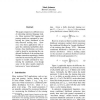Free Online Productivity Tools
i2Speak
i2Symbol
i2OCR
iTex2Img
iWeb2Print
iWeb2Shot
i2Type
iPdf2Split
iPdf2Merge
i2Bopomofo
i2Arabic
i2Style
i2Image
i2PDF
iLatex2Rtf
Sci2ools
ACL
2001
2001
Joint and Conditional Estimation of Tagging and Parsing Models
This paper compares two different ways of estimating statistical language models. Many statistical NLP tagging and parsing models are estimated by maximizing the (joint) likelihood of the fully-observed training data. However, since these applications only require the conditional probability distributions, these distributions can in principle be learnt by maximizing the conditional likelihood of the training data. Perhaps somewhat surprisingly, models estimated by maximizing the joint were superior to models estimated by maximizing the conditional, even though some of the latter models intuitively had access to "more information".
ACL 2001 | ACL 2007 | Conditional Probability Distributions | Many Statistical Nlp | Statistical Language Models |
| Added | 31 Oct 2010 |
| Updated | 31 Oct 2010 |
| Type | Conference |
| Year | 2001 |
| Where | ACL |
| Authors | Mark Johnson |
Comments (0)

